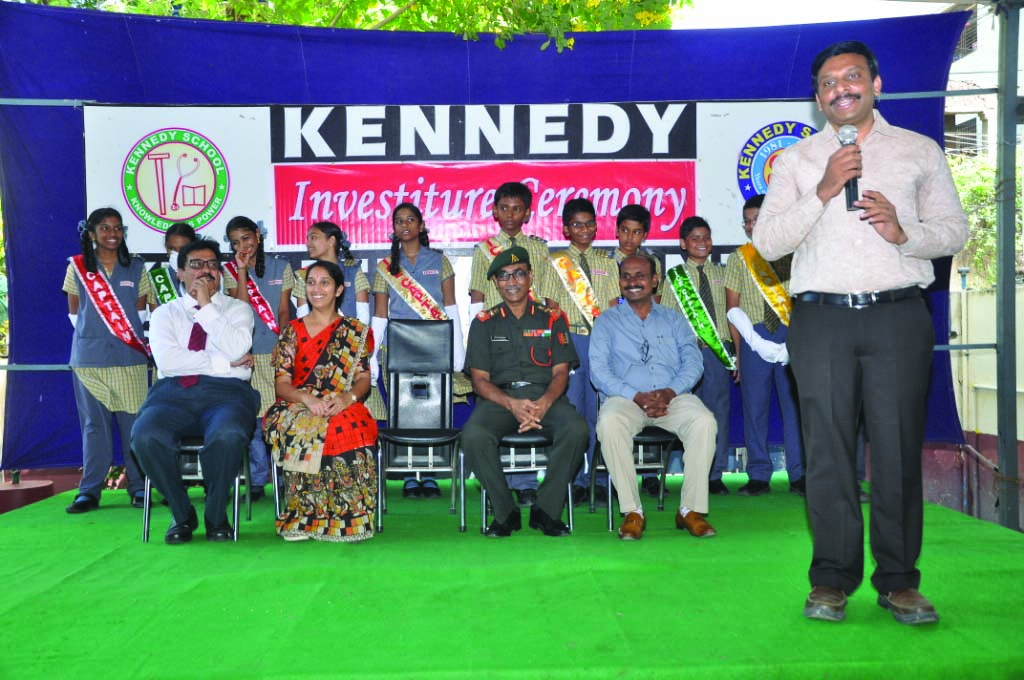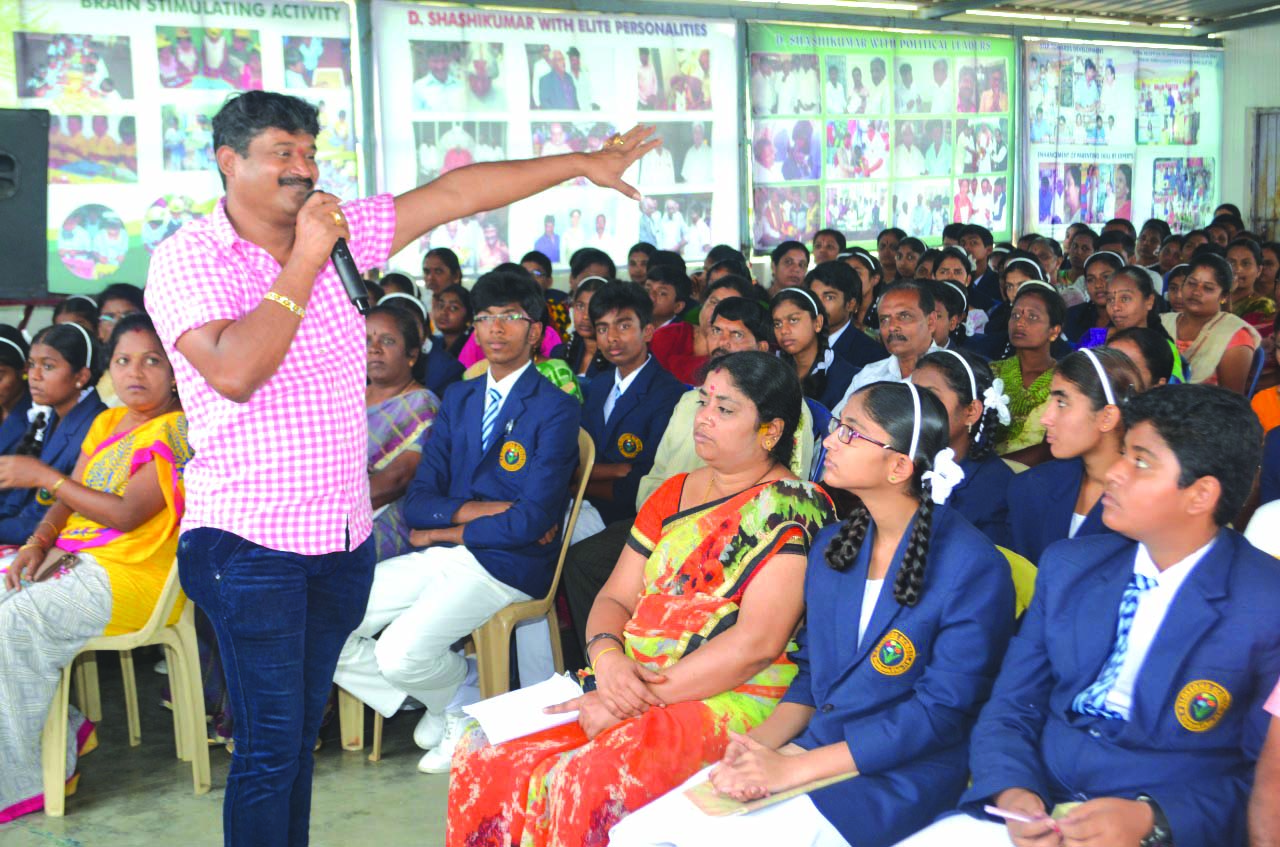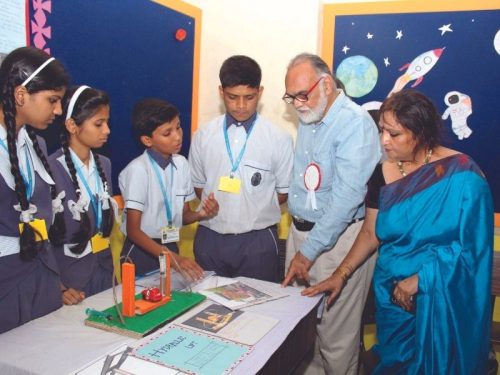India’s top-ranked budget private schools
Contrary to public opinion the number of budget private schools — an entrepreneurial response to 1.20 million state government schools defined by rock-bottom learning outcomes — is not small. 400,000 BPS countrywide have a staggering enrolment of 60 million children.

St. Mary’s HIgh School’s Bharat and Neelam Malik
In the hearts and minds of the editors of EducationWorld, promoted 22 years ago on the eve of the new millennium with the mission statement to “build the pressure of public opinion to make education the #1 item on the national agenda,” i.e, to accord top priority to human capital development, India’s unique Budget Private Schools (BPS) have a special place.
Contrary to myths manufactured by communists and leftists who dominate the academy and media, the number of BPS — an entrepreneurial response to the country’s 1.20 million state government schools defined by crumbling buildings, multi-grade classrooms, chronic teacher truancy, lack of toilets, English (Inglish) language aversion and rock-bottom learning outcomes — is not small.
According to the Centre for Civil Society, a Delhi-based think tank, an estimated 400,000 BPS levying tuition fees ranging between Rs.6,000-50,000 per year are operational countrywide, and have a staggering enrolment of 60 million children, a number almost equivalent to entire populations of Britain and France. BPS provide an alternative mainly primary and often secondary, schooling option to aspirational lower middle and working class households desperate to provide their children acceptably good English-medium education, a pre-condition of socio-economic upward mobility in the low-opportunities society shaped by post-independence India’s neta-babu brotherhood that accords low priority to mass education and human capital development.
For instance, despite several high-powered commissions and committees starting with the Kothari Commission (1967) recommending that annual government (Centre plus states) expenditure on public education should aggregate at least 6 percent of GDP, it has averaged 3-3.5 percent for 74 years. The outcome of this (some say calculated) neglect is that 21st century India hosts an estimated 300 million adult illiterates, and over 50 percent of class V children in the majority of 1.2 million government schools cannot read and/or comprehend class II textbooks and solve simple math sums.
It’s against this backdrop that one should assess the contribution of Budget Private Schools to Indian education. They offer low-priced primary-secondary English-medium education to millions of children from low-income households, providing them a chance to break the illiteracy-poverty cycle to which bottom-of-pyramid citizens are sentenced by the establishment and left liberals who dominate the academy.
The establishment loves to hate Budget Private Schools . According to them, Budget Private Schools exploit the gullible poor by promising superior English-medium education which they seldom deliver. Therefore, s.19 of the milestone Right of Children to Free & Compulsory Education (RTE) Act, 2009, mandates that BPS which don’t fulfil several infrastructure norms should be levied heavy fines, failing which they should be forced to close. However, government schools are exempt from fulfilling s.19 norms.
Moreover, during the forced government mandated 16-18 months’ lockdown of all education institutions countrywide because of the Covid-19 pandemic, the Central and state governments declined to accord BPS the status of MSMEs (micro small and medium enterprises), which would have qualified them for concessional bank loans. On the contrary, most state governments issued notifications and circulars advising parents not to pay contracted tuition and other fees to private schools, including BPS. Some state governments also passed laws slashing BPS fees even if they provided online classes. Nobody except EducationWorld spoke up for BPS schools. (See https://www.educationworld.in/dear-prime-minister-why-no-pandemic-package-for-education).
Your editors not only highlighted the important responsibility discharged by BPS for children of underprivileged households in several feature stories, but also included the country’s most respected BPS in the annual EducationWorld India School Rankings (EWISR, estb.2007), which over the years has evolved into the world’s largest and most comprehensive primary-secondary schools ranking survey. Normatively, BPS tend to maintain a very low public profile to preclude harassment from education ministry officials. Therefore, information about them is hard to come by.
However, the Delhi-based National Independent Schools Alliance (NISA) which claims 55,000 BPS among its member institutions provided the Delhi-based Centre for Forecasting & Research Pvt. Ltd (C-fore, estb.2000) which has partnered with EducationWorld ab initio to compile the EWISR league tables, a short-list of well-reputed and sufficiently high-profile BPS across the country. These BPS are rated on several parameters and ranked inter se in EWISR 2021-22.
“This year 50 C-fore researchers separately interviewed 2,458 SEC (socio economic category) ‘C’, ‘D’ and ‘E’ parents and teachers in 16 cities countrywide and persuaded them to rate BPS schools of whom they had sufficient awareness, on 11 parameters of school education excellence. The parameters include teacher welfare and development, teacher competence, infrastructure, individual attention to students, life skills and online education, leadership, value for money among others. The sample respondents were asked to rate BPS of whom they were sufficiently aware on a 100-point scale with teacher competence given double weightage. The perceptual scores awarded by the sample respondents under each parameter were totalled and Budget Private Schools ranked inter se,” says Premchand Palety, promoter-CEO of C fore explaining the rankings methodology.
In the age of the Covid-19 pandemic which devastated the economy and forced closure of all schools, including BPS countrywide for 12-15 months, there’s been no change in the seating order at the apex of top table. The highly-reputed and tightly managed St. Mary’s High School, Kalyan, Mumbai (with highest score under the parameters of teacher welfare & development, academic reputation, online education effectiveness and safety & hygiene); Muni International, Delhi (teacher competence, curriculum & pedagogy and leadership) and Mukarram Jah School, Hyderabad (co-curricular education, individual attention to students and value for money) are ranked #1 and co-ranked #2 in 2021-22 as they were last year.
However beyond the Top 3 who have retained their 2020-21 rankings, there’s been a major churn in the seating order with several BPS having risen in the public esteem and promoted to high table.
Among BPS that have made a great leap forward into high table are Jatiya Bidyalaya, Asom, Guwahati promoted to #3 cf. #24 in 2020-21 co-ranked with Little Flower Matriculation Hr Secondary School, Chennai (9), Little Star English School, Guwahati promoted to #4 (8) co-ranked with Sri Vijaya Sai High School, Nizamabad, Telangana (9) and St. Ann’s Blooming Buds School, Tivim, Goa #5 (12) jointly ranked with SR Capital Public Schools, Naveen Shahdara, Delhi (4).

Kennedy School’s Koganti (right)
Beyond the Top 5 as well, there’s been a great churning. Kennedy School, Guntur is co-ranked #6 (31) with Vasavi High School, Divya Nagar, Telangana (14); New Blossoms Education Society, Bengaluru #7 (18) co-ranked with Don Bosco High, Dombivli, Thane #7 (11); Ashwini Public School, Bengaluru #8 (10) co-ranked with the previously unranked Al-Ameen Central School, Palakkad (Kerala). Pratibha Educare, Rajamundry (Andhra Pradesh) #9 (46) — co-ranked with Nagarjuna High, Kadapa (AP) — and the previously unranked Alif School of Dual Education, Thiruvananthapuram co-ranked #10 with the Olivia Enlightened English School (sic) Siliguri, West Bengal complete the Top 10 table.
“It’s great news that we have retained our #1 ranking in the post-pandemic year. Especially because this honour coincides with our having become the first Budget Private Schools countrywide to be certified a Microsoft Showcase School. Under the guidance of the Bengaluru-based Tech Avant Garde Pvt. Ltd, our teachers underwent rigorous training with all of them now certified Microsoft Innovator Educators. As a result, we have evolved a robust digital technologies-driven hybrid model for future teaching-learning in St. Mary’s and all our affiliated schools,” says Bharat Malik, a former printing technologist and marketing professional who together with his wife Neelam, an English literature postgrad of Bombay University with six years teaching experience at St. John Baptist School, Mumbai, promoted St. Mary’s High in 1989.
Adds co-promoter Neelam Malik: “A positive outcome of the highly disruptive Covid pandemic lockdown is that our teachers have become proficient in online teaching-learning pedagogies and have transformed into valuable institutional assets. They not only developed an enabling peer learning culture, but have also involved parents’ community to improve students’ learning outcomes. As a result, all our stakeholders have become a cooperative, enabling community which augurs well for the future of St. Mary’s”.
Unfortunately, although they discharge a vital role of providing, affordably priced English-medium education to an estimated 60 million children of aspirational lower middle and working class households, there’s little appreciation for BPS. They are vilified from public platforms and in the media as exploitative institutions practising “commercialisation of education”, a cardinal sin in the socialist lexicon. Despite the Supreme Court repeatedly upholding the right of all citizens, and especially minorities, to establish and administer education institutions of their choice and to derive reasonable profit from the “vocation of education,” private school, especially BPS promoters and leaders, are fair game for politicians and education officials to harass, blackmail and rip off. According to convoluted official and leftist logic, a useless government school education provided in the local lingo is preferable to employment enabling ‘foreign’ English-medium learning. This perhaps explains why the EducationWorld India BPS Rankings introduced in 2015, accord BPS their place in the sun, have aroused huge enthusiasm countrywide.
Educationist Sreekanth Koganti, an engineering postgrad of the University of Florida, USA and director of the Kennedy School, Guntur (KSG), is delighted that this school promoted by his mother in 1981 to provide English-medium education to low-income households in the town (pop.8.75 lakh), has been acknowledged and promoted from #31 in 2020-21 to the Top 10 (#6) table this year.
“I am very pleased to learn that our school promoted by my mother 40 years ago in Guntur has been given recognition and ranked #6 among all BPS in India. It is a fitting tribute to her public service. It is also a fitting reward for our teachers who worked very hard to transform KSG into the first BPS in Guntur district to begin online classes during the pandemic lockdown. Despite not being awarded MSME (micro, small, medium enterprise) status, we were fortunate to obtain a bank loan to install Internet connectivity and purchase digital devices to wire up our classrooms. This enabled us to maintain the learning continuity of our children. Now with all students back in school since September, our remedial classes are fast recovering their learning loss. The high Top 10 ranking awarded to us by your sample respondents is certain to motivate our teachers, parents and students,” says Koganti, who has also promoted two non-BPS schools under the name and style of NextGen International in Andhra Pradesh. Currently, KSG (annual fees: Rs.24,000), has 1,650 boys and girls and 95 teachers on its muster rolls.
Another BPS that has been given a massive endorsement by the 2,458 SEC (socio-economic category) ‘C-E’ sample respondents specially interviewed to rate the country’s most respected BPS on 11 parameters of affordable school education excellence, is the New Blossoms Education Society, Bengaluru (NBES, estb.1993). Ranked #18 nationally in 2020-21, NBES is promoted to #7 countrywide and #1 in Karnataka (pop.68 million).
“BPS don’t get any recognition from society or respect from the media. That’s why news that NBES is ranked among India’s Top 10 BPS and #1 in Karnataka, is very encouraging. Our teachers and staff have worked beyond the call of duty to ensure continuous online learning and have developed our own learning platform named Hybrid Vidya which broadcasts daily lessons to 400 state board schools with a combined enrolment of 55,000 students in Karnataka. I am confident that Hybrid Vidya will remain an enabling supplementary teaching-learning programme for parents in the post-pandemic era,” says D. Shashi Kumar, promoter-director of NBES, which had a pre-pandemic enrolment of 1,800 students and 64 teachers on its musters.

New Blossoms, Bengaluru’s Shashi Kumar
Undoubtedly and to a significant degree, the national and statewide recognition that NBES has acquired is due to the indefatigable education activism of Shashi Kumar, a holder of several diplomas in paramedics and pharmacy, who starting as a school student has acquired “over 39 years of experience in school administration and management” and promoted NBES 28 years ago.
Coterminously, he has evolved into a nationally acclaimed champion of private K-12 education, especially budget private schools.
In 1993, he registered KAMS (Associated Managements of English Medium Schools in Karnataka) which won Supreme Court verdicts ruling that parents have the right to choose the medium of instruction in school education, and state governments cannot arbitrarily reduce and regulate tuition and other fees levied by private schools. For his continuous advocacy of private schools and for exposing corruption within the state government’s education ministry and sundry departments, Shashi Kumar has aroused the wrath of myriad vested interest groups. On July 29 while driving home from work, he was waylaid and attacked by three machete-wielding goons. Kumar scared them away by firing from his licensed revolver. “The roots of corruption in education run deep in Karnataka,” says Kumar.
The EWISR 2021-22 league table of India’s most well-regarded BPS comprising 629 low-priced schools is set out in the pages following.
Also Read:
















Add comment